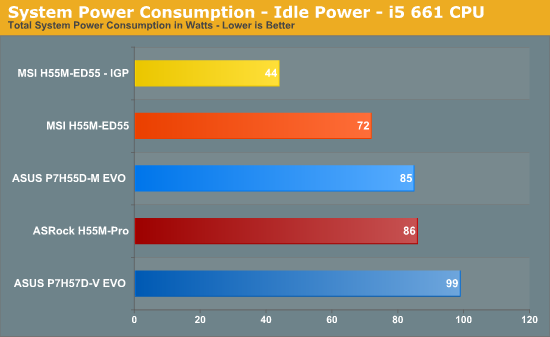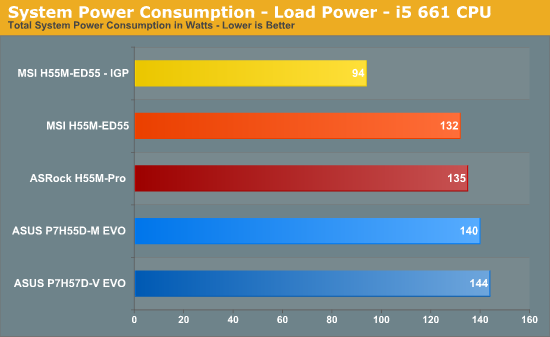Choosing the Best H55/H57 Motherboard - Part 1
by Rajinder Gill on January 31, 2010 11:30 PM EST- Posted in
- Motherboards
Testbed Setup and Power
| Testbed Setup - Overclocking / Benchmark | |
| Processor | Intel Core i5 661 ES CPU - 3.33GHz - 2 Cores 4 Threads, 4MB Cache |
| CPU Voltage | Various |
| Cooling | Intel air cooler Heatkiller 3.0 waterblock PA120.2 radiator and DDC ultra pump (with Petra top) 1/2 ID tubing for watercooling |
| Power Supply | Corsair HX950 |
| Memory | Corsair Dominator CMD8GX3M4A1600C8 1600MHz 8GB kit G.Skill Perfect Storm 8-8-8-24 2200MHz 4GB kit Corsair Dominator GT 8-8-8-24 2200MHz 4GB kit (X2 for 8GB) |
| Memory Settings | Various |
| Video Cards | MSI 275 Lightning (stock clocks) |
| Video Drivers | nVidia 195.62 WHQL |
| Hard Drive | Western Digital 7200RPM 1TB SATA 3/Gbps 32MB Buffer OCZ Vertex 120GB SSD |
| Optical Drives | Plextor PX-B900A Toshiba SD-H802A |
| Case | Open Test Bed - Dimastech Benching Station Lian-Li V2110 |
| Operating System | Windows 7 64 bit |
| . | |
We utilized memory kits from Corsair and G.Skill to verify memory compatibility on our test boards. Our OS and primary applications are loaded on the OCZ Vertex 120GB SSD drive and our games operate off the WD Caviar Black 1TB drive. We did a clean install of the OS and applications for each motherboard.
We used Intel's stock cooler for the stock comparison testing, while water-cooling via the superlative Heat Killer 3.0 water block was utilized for overclocking. For graphics duty, we used MSI's GTX 275 Lighting GPU to provide performance comparisons between boards during gaming benchmarks.
For our test results we set up each board as closely as possible in regards to memory timings. Otherwise all other settings are left on auto. The P55 utilized 8GB of DDR3 (apart from DFI's MI-T36 which is limited to 4GB), while the X58 platform contained 6GB. The P55 and X58 DDR3 timings were set to 7-7-7-20 1T at DDR3-1600 for the i7-920 and i7-870 processors at both stock and overclocked CPU settings.
We used DDR3-1333 6-6-6-18 1T timings for the i5-750 stock setup for all system benchmarks (non-gaming tests) as DDR3-1600 is not natively supported at a stock BCLK setting of 133.
For our Clarkdale i5 661 CPU, we used 7-7-7-20 1N timings at DDR3-1333MHz with 8GB of memory. We would have preferred to use CAS 6 timings to match our Lynnfield setup, but it seems 8GB of memory at CAS 6 on Clarkdale is not possible right now. The 4GHz gaming results used 8GB of memory at DDR3-1200 with CAS 6-6-6-18 1N timings to allow a BCLK of 200MHz with the QPI ratio in sync with CPU frequency.
There's little to separate these boards when you run them at a fixed frequency, showing nothing more than a 1-2% swing in most instances, which goes completely unnoticed in real world usage.
Power consumption
Our power consumption testing utilizes the same batch of components under similar circumstances in a bid to monitor variances between idle and CPU load conditions using an AC wall meter for power consumption measurements. We install the vendor supplied power saving utilitites on each board and enable power saving modes that don't involve any kind of underclocking or CPU core frequency modulation in order to run an apples to apples comparison.
Assuming a maximum 150w load in the worst case scenario, actual motherboard power consumption is around 15%~17% lower than the shown figures if you factor out switching losses at the PSU.


MSI continues in its dominance of idle/light load power saving performance by using buck controllers that support low switching speeds and allow phases to be turned off in light load conditions.
A graphics card like nVidia's 275 will add around 28w of idle power consumption to a Clarkdale system. It is unfortunate that Intel (and board vendors) do not offer drivers/GPU power management that allow a discrete GPU to be powered on/off on demand - the power savings would be rather attractive.
Note that most of the CPU VCC power saving features on these boards need to be turned off when overclocking to ensure system stability and to prevent PWM burnouts under modulating loads at higher levels of current draw. With power saving features switched off, you get a 5~10W increase in the idle power consumption at the same operating frequency, while load power consumption remains roughly the same due to current loading.










56 Comments
View All Comments
just4U - Wednesday, February 3, 2010 - link
Ever since I read about there being problems on the 1156 boards with certain sockets... I've been leary about buying any 1156 boards. I'd heard reports that it was happening even to those not overclocking and for me that's cause for concern. I look at all the offerings and wonder..Is it fixed? Which boards would be effected? I'd like more info on that before I even consider purchasing the i5/i3 etc. Perhaps Anand can include information on all this in part2 or 3?
Thanks.
Rajinder Gill - Wednesday, February 3, 2010 - link
Hi,There have been no official updates from socket vendors/intel/board vendors as to the exact cause of socket burnouts we experienced on some fo the early 1156 boards. To date, it appears the majority of issues reported have been on boards that were manufactured pre September 2009.
FWIW, all of the sample boards I've had for H55/H57 have arrived with Lotes sockets so far, although I'm not sure if that means vendors are not using Foxconn altogether. We have not seen any issues in testing thus far.
regards
Raja
just4U - Wednesday, February 3, 2010 - link
Yeah that's another thing that keeps me put off. Is I don't know which boards are using the Foxconn. Anyway thanks for the reply back.thaze - Wednesday, February 3, 2010 - link
I just received a Gigabyte GA-H57M-USB3 and an Intel Core i3-530.An interesting feature seemed to be the Dolby Home Theater (i.e. Dolby Digital live encoding). However its software is hard to find, there's no reference in the Gigabyte CD's main menu. I eventually found it at \utility\dolby\. Install went fine but the program is crashing when executed. Maybe someone could confirm the same problem running Win 7 x64.
thaze - Friday, February 5, 2010 - link
"I've forwarded your problem to our HQ, and your problem is duplicated.A solution will be provided by HQ very soon.
Please just wait for my further information later."
Rajinder Gill - Friday, February 5, 2010 - link
Hi Thaze,Gigabyte messed up on this one, their engineers forgot to add the BIOS string to unlock the Dolby features on the H55/H57M-USB3 models. BIOS F3a beta (Jan 8 dated I think) was pulled a couple of days ago from their support page and is due to be replaced with an F4 BIOS fixing the problem.
regards
Raja
thaze - Saturday, February 6, 2010 - link
Thanks again for the details. F4 is out now and I can finally use Dolby Home Theater. :)Rajinder Gill - Wednesday, February 3, 2010 - link
Hi,Just testing the GB boards now, so will get back to you with an answer on this asap. I'm on Win 7 64 bit.
regards
Raja
Rajinder Gill - Wednesday, February 3, 2010 - link
Hi,It appears you are correct. I just installed the Dolby X64 package and when I try to run the software, it crashes.
regards
Raja
thaze - Wednesday, February 3, 2010 - link
Thank you for your reply.I also sent a message to GB support yesterday, will inform about their statement here.